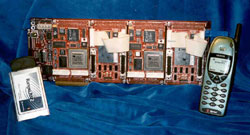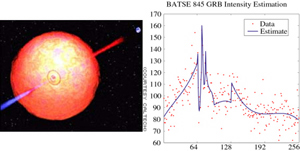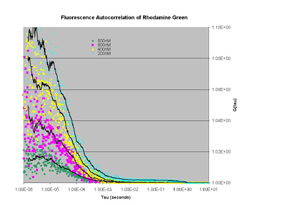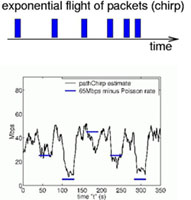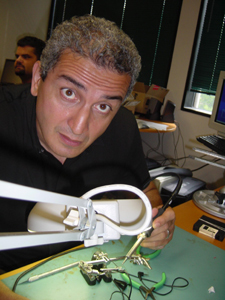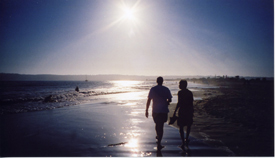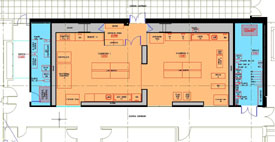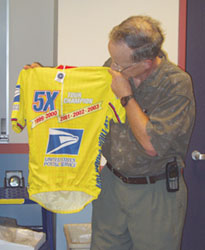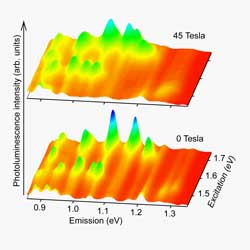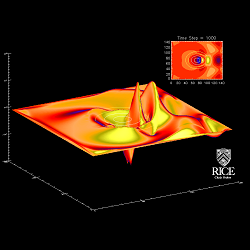


Professor Frank Tittel perches on the edge of the Marsaya volcano outside of Managua, Nicaragua. For additional information on the Laser Science Group's volcano experiment, check out the Rice News.

Image of a transmission electron micrograph (TEM) of a collection of hollow nanoshells made of titanium dioxide. Crystals are made of these hollow shells and characterize their optical properties. For additional information, contact Professor Daniel Mittleman.
"2 ECE Profs. dressed up
The Artist's conception on the left was taken from an article on
CNN.com at http://www.cnn.com/TECH/9909/29/gamma.rays/
Disco Stu lost his first game, but went on to win six
straight games to
reach the final round, where he won using a simple, elegant strategy.
Disco Stu's strategy required only three turns, a bit of line
following,
and finding a wall, and his reliable execution led to success. For
more
details, go to http://www.owlnet.rice.edu/legolab.
For more on Rice's communications
and sensor networking research, see http://cmc.rice.edu.
For additional information, please see the recent Rice
News article.
A paper describing this research has been published in Science. The article has also been
covered by several science and technology websites, including: http://physicsweb.org,
http://www.innovations-report.com,
http://www.betterhumans.com, and http://nanotechweb.org
The TFA Wireless Network will serve as an initial platform for the multi-hop
wireless backhaul platform of custom hardware that is being developed by
physical layer, media access layer and routing layer groups on the TAPs
project using the Center for Multimedia Communication (CMC) Lab and
extending throughout the Rice campus. Seen in Figure 2, the nine square
miles of TFA wireless coverage all shared from one wired connection offers a
glimpse of the future with TAPs.
Last modified: October 11, 2004

Take the Abercrombie Lab area devoted to microprocessor-level hardware
and special computer engineering projects, stir in a desire to
modernize the computer engineering curriculum, add enthusiasm on the
part of Patrick Frantz
(Executive Director of the Center
for
Multimedia Communications) and Professor Cavallaro,
sprinkle in money
to purchase high-performance Dell Computers from Rice's Information
Technology Group, and bake quickly (renovation to first day of class
was 6 weeks!). Out of the oven springs an award-winning (Texas
Instruments Elite Lab) senior DSP lab using state-of-the-art DSP
development environments.
This is a photograph of a Mid-IR diode laser based gas sensor placed
in
a SUV at the Santiago crater rim of Masaya volcano. Professor Frank
K. Tittel can be seen in the background. For additional information,
see the Laser Science
Group homepage.
This is a photograph of a robot built for Elec 201: Introduction
to Engineering Design. The robot was built in 1999 by Ilana
Bromberg, Erin Engelhardt, and Pete Irot.
The 2000 LEGO Robot Contest will be held on Sunday, December 3 at
1:30pm in Duncan Hall. For additional information,
contact Professor James F. Young at young@rice.edu.
This is a photograph of a prototype board developed by Sundance DSP
which is accelerating the simulation of the algorithms which are being
developed for Wideband Code Division Multiple Access (WCDMA) advanced
receiver structures. Researchers involved in the Texas
Instruments-Nokia-Rice
Wireless Communication Testbed Project include Professors Behnaam
Aazhang and Joseph
Cavallaro. For additional information,
please check the Center for
Multimedia Communication.
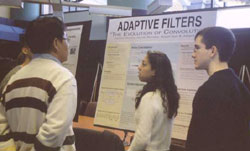
Undergraduate students reviewing a poster presented during the Elec 301 (Signals
and Systems) poster presentation on December 14.

ECE grad student Jeremy Pearce working on his Elec 599 project using
the new `T-Ray 2000' installed in Dr. Mittleman's Lab in February by
technicians from Picometrix, Inc. Rice is acting as the beta test
site for this new device, the world's first commercial terahertz
spectrometer.
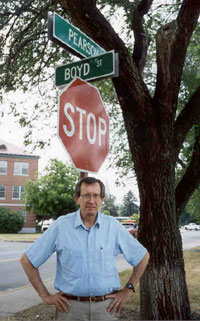
Professor Emeritus
J. Boyd Pearson, Jr., stands at an intersection at Wright-Patterson
AFB. Pearson recently received an "Outstanding Recognition" award
from the NSF "For pioneering contributions to research and education
in multivariable and robust control systems under continuous
NSF funding from 1973-1998." He received this award at "PearsonFest: New
Directions in Dynamical Systems and Control", a workshop in his honor
held at Rice March 9-10, 2001.

Pictured is a set of vials displaying the growth sequence of gold
nanoshells made in the Halas
group. The solutions mark the
progression of electroless gold plating onto a core silica
nanoparticle with a 171 nm diameter. The red solution is gold colloid
with a 20 nm diameter. The amount of gold deposited on the silica
core increases from left to right. The first three vials contain
particles with islands of gold increasing in size. The next three
solutions are of complete gold nanoshells with shells of thickness 8
nm, 13 nm, and 40 nm, respectively.
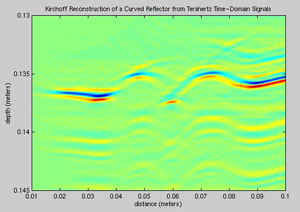
This image shows a reconstruction of a curved reflecting
surface, formed using terahertz multistatic imaging. This
imaging system mimics the data acquisition and signal processing
used in geophysical processing, and therefore could be useful
for studying table-top model systems. Kirchoff migration accurately
reproduces the anticlines and the syncline in this model reflector.
For more information, contact Dr. Mittleman or see his web page
at www-ece.rice.edu/~daniel/Mittleman.html.
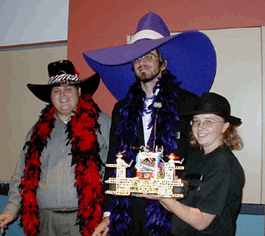
Winners of the ELEC 201 Introduction to Engineering Design, 2001 LEGO
Robot contest.
Team #4, Manny "Mac Daddy" de la Mora (Junior in Anthropology), Sid
"Chief Sloth Artist" Byrd (Junior in Computer Science), and Kathryn
"Kat"
Dalton (Senior in Chemistry and Spanish), with their robot PimpBot.
For
more information on the course (sponsored by Industrial Affiliate
Motorola) see
http://www.owlnet.rice.edu/legolab
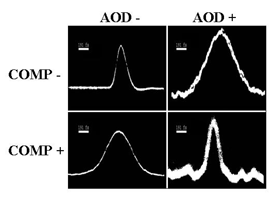
Autocorrelation traces of Gordana Ostojic's ultrafast Ti:Sa laser in
Jun
Kono's lab. The traces show compensation of the
group-velocity-dispersion of
a highly dispersive acousto-optic deflector using a "double decker"
prism
pair pre-chirper constructed by Vijay Iyer and Brad Losavio in Peter
Saggau's lab at the Baylor College of Medicine . This work was
presented at
the Photonics West conference this January. Such a pre-chirper could
be
included in an eventual fast scanning two-photon microscope for neural
tissue studies. Autocorrelation traces obtained by Vijay Iyer.
http://www.bcm.tmc.edu/scbmb/faculty/faculty/saggau.html

The ECE Department invited several potential graduate students to
meet with faculty and students and to tour the campus February
21-24.
Picture of current ECE graduate students and potential ECE recruits
at
Buca di Beppo on Friday, February 22. Photo courtesy of Krishna K.
Mukkavilli.

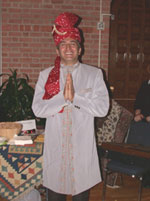
Professors Behnaam Aazhang and Joseph Cavallaro participating in the
culture fair of international students at Rice.
as Maharajas (kings) one fine day.
One wondered how he got into this mess,
while the other, folding
hands, said "Namaste".
Everyone who missed the show
with the perenially-entertaining duo
at their height
needs to be shown this abolutely hilarious sight
Needless to say, they landed on the ECE web page."
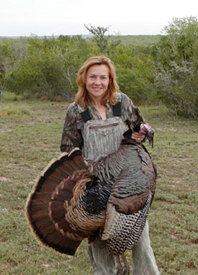
Professor Naomi Halas, winner of the Live Oak Soil and Water
Conservation District 2002 Conservationist of the Year Award,
proudly displays the turkey she recently shot on her
Live Oak County Ranch.

ECE Seniors Erik Welsh and Patrick Murphy presenting their poster
entitled "A Mobile Testbed for GPS-Based ITS/IVC and Ad Hoc
Routing
Experimentation" at the Rice Undergraduate Research Symposium (RURS) on April 21.
Both Erik and Patrick will be entering the ECE graduate program
this Fall.
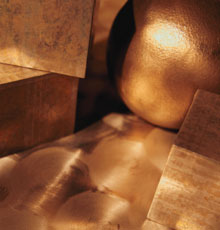
Naomi Halas' research on "The Optical Properties of Nanoshells"
made the cover of the August issue of Optics & Photonics News
(OPN).
Gamma-ray bursts -- quick, extremely intense bursts of gamma rays (see
Artist's conception above, left) -- are one of the most energetic, and
yet
enigmatic, phenomenon in the known universe. Graduate student Rebecca
Willett and Professor Robert Nowak have developed a new method based
on
wavelets for estimating the time-varying intensity of these bursts
(above,
right). Their technique may help astrophysicists determine whether
these
bursts are due to star formation, supernovae, or other cataclysmic
events.

Winners of the ELEC 201 LEGO robot contest: Tiffany Truss (sophomore,
undeclared engineer, Wiess College), Stephanie Clark (sophomore, art
major, Baker College), and Gary Printy (senior, ELEC major, Baker
College), with their robot Disco Stu.
First autocorrelation traces obtained using a newly constructed
Multi-Photon Fluorescence Correlation Spectroscopy (MP-FCS) apparatus
in
Neal Waxham's lab at the University of Texas-Houston in the Texas
Medical
Center. Work done by ECE graduate student Vijay Iyer. Traces represent
the
autocorrelation of photon-counting data obtained from Rhodamine Green
dye
fluorescence in free solution. Such traces allow parameters such as
concentration and diffusion constant to be obtained for low
concentrations
of fluorescent molecules in very small (femtoliter) volumes, in a
variety of
molecular environments.
Graduate Student Vinay
Ribeiro won "Best Student Paper Award" at the Passive and
Active
Measurement (PAM) Workshop in La Jolla, CA. His work was on
modeling the dynamics of end-to-end paths through the internet. His
tool "PathChirp", developed in colloboration with ECE Professor
Richard Baraniuk, ECE Faculty Fellow Rolf Riedi, and Jiri Navratil and
Les Cottrell from Stanford, sends "probe packets" through the internet
and then statistically analyzes when they arrive at the receiver to
determine the critical network paramaters like the bandwidth
("connection speed") available to users.
Professor Behnaam Aazhang puts the finishing touches on one of Rice's
latest "MicroGnomes", micro-sized wireless sensor nodes for
building sensor networks in the Center for Multimedia Communications
(CMC) lab in Duncan Hall.
Justin Romberg and Ramesh (Neelsh) Neelamani walk off into the sunset
at Coronado Beach in San Diego after attending Wavelets X, the final
conference of their Rice graduate career. Both recently completed their
doctoral research with advisor Richard Baraniuk. Justin is off to a
postdoc at Caltech and Stanford, Neelsh a position in Exxon-Mobil's
research division.
Construction will begin in October on the new Rice Nanofabrication
Facility, in the south wing of Abercrombie. This will be a class
100/1000 clean room, with capabilities for photolithography, RIE, CVD,
and
various other processing tools. Completion is scheduled for May
2004.

ECE Senior Paul Rodriguez part of team that wins second place at
Society of Hispanic Professional Engineers (SHPE) Academic Olympiad.
For additional information, go to http://www.ece.rice.edu/News/alaes-conf04.html.
Don Johnson holding up the championship yellow jersey he received for
5 years
as the ECE Department Chair. He was presented with this jersey at a
surprise
"Stepping Down" party held
in his honor on May 4, 2004.
Jun Kono has led a group of researchers in a study of semiconducting
single-walled carbon nanotubes (SWNTs). In the image above, the peaks
represent the amount of light given off by
semiconducting carbon nanotubes via "interband photoluminescence", a
quantum
process that emits light whose photon energy is given by the
band-gap width (See Rice Press Release).
This is a FDTD (Finite Difference Time Domain) simulation of a
multilayer
nanostructure, or a nanomazrushka. This movie depicts the time evolution of
the electric fields in a plane which bisects the nanostructure. This
system, created and studied here at Rice, recently appeared in Science
(Vol
302, Issue 5644, 419-422). Researchers involved include Chris Oubre,
Peter
Nordlander, Emil Prodan, Naomi Halas and Corey Radloff.
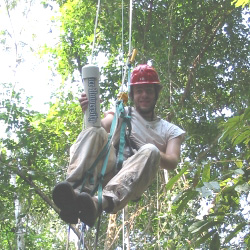
William Mantzel, a Masters student in the Rice DSP group
hoists a wireless sensor node 30m up into
the rain forest of the Los Amigos Conservation Area in Peru. The goal
of the project is to deploy a distributed network of wireless sensors
to measure microclimatic conditions in a delicate vanilla palm
swamp. William, undergraduate Tom Mowad, and advisor Prof. Richard
Baraniuk are collaborating with the Botanical Research
Institute of Texas and are supported by the Moore Foundation.
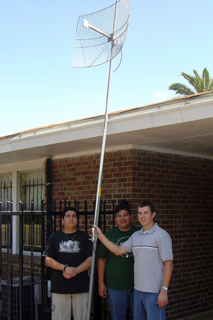
Rice Networks Group (RNG) and Technology for All (TFA) are building a multi-hop
wireless network using current off-the-shelf hardware as both a
proof-of-concept for the Rice Transit Access Points (TAPs) Group and a
cost-effective broadband internet service provider to the low-income
communities of Southeast Houston. Joseph Camp, a masters student advised by
Dr. Ed Knightly, spent the summer working at TFA to design the network and
will continue to work with TFA this semester to deploy the network.
Pictured in Figure
1 from
left to right are Jesse Linares(TFA), Pete
Rodriguez (TFA), and Joseph Camp (Rice Networks Group) with the first
directional and omni-directional antennae for the TFA Wireless Network.
![]()


